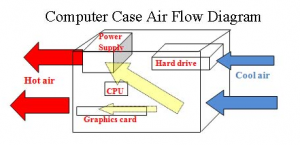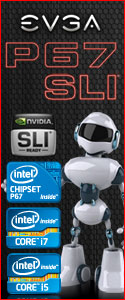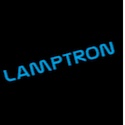In today’s world of hot, heated hardware, there is a product for just about every price zone which can either been seen as an advantage or, to many who are inexperienced with the latest tech churning out by many companies, a huge headache. Trying to find the best value for the money can be challenging even for the avid hardcore techie. Coolink is a company that hopes to rectify things and make it a lot easier for you, the consumer, with their products as their branding stands for “an effective conjunction of no-frills performance, excellent quality and attractive pricingâ€ÂÂ.
About Coolink
“While Coolink held a strong presence in the Asian market ever since the late 90ies, it was not until 2005 that the brand was introduced to the European market on a large scale. After the launch of Coolink-Europe.com in late 2005, Coolink quickly became a well recognised brand for high-quality cooling components in Europe too.”
“Kolink International Corporation is a cooling specialist established in 1996 and well known among industry insiders. Throughout the years, Kolink designed and manufactured many top-performing heat-sinks under various brand names that succeeded in international markets. An experienced R&D team and ultra-modern production plants in Taiwan ensure continuous progress, efficient manufacturing conditions and strict quality standards.”
Fans
From this reviewer’s perspective, Coolink isn’t a brand to normally associated with top performance and/or quiet cooling. Their latest SWiF2 fans have been around since as early as July, yet we had not heard of them. Rather being over shadowed by some top name brands of the likes of Noctua, Sharkoon, Scythe, and many more. However, with regard to the latest SWiF2 fans we will be reviewing today, Noctua has personally handled their marketing and product – which to many readers’ eyes can only be something of a great benefit we hope?
Company CEO Statement
“ With more than a hundred thousand satisfied users, our Silent Whisper Fans have created a huge following among those looking for true high-end fans at a reasonable price”, says Timothy Chu, Coolink CEO. “Today, we’re thrilled to revive the series with new, further improved models as well as an exciting new colour scheme. Of course, the new SWiF2 family remains true to our vision of linking excellent quality with attractive pricing.”
Featuring an all new 11-blade impeller design, the design goal for the SWiF2 120mm fan was to improve its airflow and airflow to noise ratio, making it suitable for a broad range of applications. Thanks to its unique blade design, the SWiF2 120mm improves upon its successful predecessor’s airflow to noise ratio by up to 40% at low fan speeds.
Cooling
Cooling. Where do we start? If you’re like this reviewer, fans & upgrading go very much hand in hand. It wouldn’t be surprising to find that your avid hardware enthusiast would go through 20+ different kinds of fans, brands, types & sizes in 12 months. Why would we, as consumers, go through so many in what many feel as such a short period of time you may wonder? It may well have something to do with a lot of marketing, word of mouth, reviews and too much time on forums.
You can understand then it is a very hard task indeed from a company’s perspective to sell products like fans to what would be considered an already controlled area by top branded companies. For instance, you as a reader and purchaser come to learn, know and love a brand such like Noctua from reading far too many reviews and listening to far too many ‘fanboys’. Why would you swap your (expensive) fans out for something that boasts the same when you already know that (what you perceive) is already the ‘best’? It’s a hard decision to make and something all companies try to compete for – your mindset and values. Can we manipulate your views today with Coolink’s new SWiF2 fans? Let’s have a go.
SWiF2 – Can a sequel ever be better than the original?
We had four sent to our office (dubbed the “Silent Whisper Fanâ€ÂÂ) this morning and couldn’t wait to unwrap the large box and check out the goodies Noctua had sent us. Personally, from a marketing perspective, the packaging on the Coolink fans is very eye catching and well laid out indeed. The packaging on the fans is just our style and goes well with the product. The colour scheme is also great! With the colour of the fans though, we were presuming they were ‘glow in the dark’ perhaps, but don’t seem to be from first glance.
We shall be taking a look at:
92mm
SWiF2-92P
SWiF2-921
120mm
SWiF2-120P
SWiF2-1201
Specs
Coolink has this to say – “Based on the award-winning original SWiF design, the new SWiF2 series of high-performance quiet fans takes its successful predecessors’ proven qualities one step further by adding hydro-dynamic bearings as well as a unique, exciting colour scheme. Featuring an innovative, all new 11-blade impeller design (120 mm model only) that achieves vast improvements in airflow/noise efficiency. The new hydro-dynamic bearing ensures whisper quiet operation and even better longevity, which is reflected in an enhanced warranty time of 60 months. Now also available with support for PWM fan speed control, the SWiF2 series provides excellent silent-performance and includes a full range of trusted Coolink quality fans, suitable for all applications inside your system.”
Features
Innovative 11-blade impeller design (120 mm model)
Supports PWM fan speed control (SWiF2-92P/120P)
High-performance hydro-dynamic bearing
Protective cable sleeving
Anti-Vibration Bolts & Screws
PWM y-split cable for connecting multiple PWM fans (SWiF2-92P/120P)
Details
92 mm model
120 mm model
** It’s worth noting that the airflow is in cubic meters an hour, to convert to CFM, multiply by 0.58.
Early Reflection
Among all the impressive stated specs and info, the main thing that jumps out to us is the 60 month warranty. That’s 5 years of warranty for just a fan to those that can’t be bothered to crack out a calculator. That’s unbelievable customer satisfaction right there. With regards to the 120 mm models, the dB rating of 18.2 at 1200RPM is very attractive indeed, but we all know every fan making company over-exaggerates their specs.
The Product
The Coolink SWiF2 fans come packaged in a colourful vector style white and purple box with yellow accents and a see-through window to display the yellow/green impeller of the actual fan itself.
On the back is a full description of the features, noise level comparison and specifications of the enclosed fan.
All the fans come with identical accessory packs that include screw plugs (Anti-Vibration), screws and an adapter harness for the four pin connector (PWM models only).
Looking at the overall feel of the fan, the build quality is very strong, sturdy and well built indeed. They don’t feel cheap and nothing is loose at all. Props to Coolink!
However that said, there is a minor cheap feel to the fan with respect to the cable braiding job they have done on all fans. They have only used heat-shrink to braid the fan which it does tidy the fan wiring up, but the job they have done looks very amateur. We feel like grabbing our lighters and finishing the job ourselves to be perfectly honest. It’s simply too wide for the cables, and thus not too secure.
Sound Testing
Detailing the noise attributes of these kinds of fans can be rather subjective and to some extent wrong perceived by those who have a different ‘comfort level’. As we don’t currently own some high performance Anemometer’s to measure the CFM and/or sound level meter to accurately measure the dB rating, we shall not be going much further in detail to prove and back up the stated specs for those reasons.
Not to miss a whole section completely on noise output (which is vital to the fans branding), I will however detail what each fan is like and compare to some popular brand name fans for you, the reader, to get a better idea of performance.
SWiF2-921
Having not owned any 92mm fans in the past, I unfortunately can’t compare to a well known fan. 92mm fans in this reviewers opinion are neither worth their weight in gold to man nor beast. That said, the performance of this 921 is great. Sound levels are good for a 92mm fan. We were expecting it to be rather loud due to the size (fan having to work harder to push more air than larger fans), but to our surprise, the fan pushes quite a bit of air and the sound level was very quiet indeed especially for a fan spinning at 1500RPM. Great for a small media centre or server.
SWiF2-92P
The 92P (PWM version) was a different story. At full speed (1900RPM), the fan was obviously audible to the ear even from a short metre distance away. However, the fan wasn’t that noisy. We would say right on the limit in terms of comfort levels sitting next to the PC. When we hooked it up to a fan controller and tried it at different speeds we found that at its lowest speed (625RPM), it didn’t push any air at all placing the back of our hand behind it; it was however 100% silent. At near double the speed at 1200RPM, the fan was extremely quiet and pushed quite a bit of air for the noise level it produced which is very impressive and we back up our statement earlier for using these for server/media centre builds.
SWiF2-1201
The 120mm fan industry is very competitive being that it is the sweet spot for fans right now from basic to enthusiast builds. The 1201 model is very impressive in terms of the amount of air pushed and the noise level at its rated 1200RPM. I do however feel its claim of 18.2dB is a little low, more around the 24dB area but is still very quiet.
To put things into perspective in relation to some other popular fans on the market, we have a big winner on our hands with the 1201 model. Not only does it push more air than a Noctua NF-S12B FLX and Sharkoon 1000 Golf Ball, but its sound level is on par with the Noctua FLX series. It’s not to the sound standard of the 1000 from Sharkoon (quieter than the Noctua series fans and pushes more air from this reviewers opinion), but boy does it move a bit more air. It may well be a tad (when we say a tad, we are talking about 1-2dB here) louder and have a slight different tone to the Sharkoon 1000 (Sharkoon 1000 has a slight low basey moan to it close up and disappears once you move 15 cm away, where as the 1201 from Coolink has more of a whirling tone to it which has more to do with the air resistance being pushed), but the added extra CFM it pushes makes up for it indeed.
Coolink claims 54CFM at 1200RPM & 18.2dB as previously mentioned. With reference to Bit Tech/Custom PC’s recent 120mm round up of fans featuring the true to its spec Sharkoon 1000 Golf Ball 120mm fan which they found to push 36CFM at 20.7dB, we can safely say that this fan would push near 40CFM but at 24dB. Great specs none-the-less.
SWiF2-120P
So, what about the PWM version of the 1201 then? From our perspective, we have come across a new fan for our needs. Coolink has done a very good job with the 120mm series. At 800RPM, the fan was still pushing a bit of air and was silent. However, the amount of air pushed wasn’t that great and would be useless for CPU/GPU coolers and intake/exhaust on performance cases. Coolink states at its lowest speed it pushes roughly 35CFM, but I’m afraid that is way off. You don’t hit that area of CFM until the 1000+ RPM territory.
At its full speed of 1700RPM, the fan was quite loud, but pushed a lotof air! Coolink claims at its full fan speed, it pushes 74CFM. Having owned a few San Ace H1011 fans for water-cooling rads and knowing what CFM they push at full speed (99CFM) and being backed up by many fan reviews on the web, 74CFM for this 120P is about right, if perhaps a tad lower. With benchmarking in mind, this speed & CFM is very much appreciated and the sound level doesn’t sound like a hover either. Very well done Coolink.
Testing the fan at other speed levels to find a nice comfort level for noise to CFM ratio, we found that at around 1100RPM tops was a great setting for this fan model. Not only did it push more air than both Noctua and Sharkoon fan rivals, but the sound level was quieter too (just).
Test Method
We shall be using the bang for buck Xigmatek-HDT-S1283 cooler from Xigmatek. To get an idea of how the 120mm fan performs on the market, we shall be putting it up against the rival fans already mentioned in this article that this fan is aiming to steal the market share from; the Noctua NF-S12B FLX, & the Sharkoon 1000 Golf Ball. In theory, we should be using the P12 from Noctua as that is optimised for Heatsink/PSU cooling use due to the better static pressure produced. However, since both Sharkoon and Coolink fans seem more optimised for case cooling, it would be rather unfair to use the P12 series from Noctua, so instead we shall use the FLX optimised case cooling fans here instead.
That’s not to say these Coolink fans should not be used on heatsinks for CPU/GPU cooling as the company states they are ready for a broad range of cooling methods. Though we must state, it’s suggested if you want to cool CPU heatsinks, PSU’s, or cases with restricted airflow i.e. dense dust filters, you should find a fan that has high static pressure properties like the P12 from Noctua, Scythe S-Flex series, or any 38mm thick fans like the San Ace H1011’s. For an interesting look, we have included a San Ace H1011 into the mix for a temperature comparison. Testing was done out of case on a bench table and fans were placed in a ‘push’ configuration on the cooler.
System
AMD Phenom II X3 705e UNLOCKED @ X4 4Ghz w/ 1.5v
Biostar TA785GE 128M
2GB OCZ Reaper PC2-8500
320GB WD AAKS Caviar Blue
Corsair VX 450W
With regard to fairness and objectivity, the following procedure was used. Since we have no 92 mm heatsinks, we will not be testing the temps for the 92 mm models. For the 120 mm however, we will be using just the PWM model only and setting it to run at the 1200RPM spec the non-PWM model runs at. We shall be seeing what it does at high speed settings too. Since I’m using an ‘unlocked’ AMD chip, Core temp is unable to monitor temps as well as AOD. Thankfully, BIOSTAR provide an Overclocking utility application (T-Utility OverClock III) and hardware monitor linked to the BIOS of the board thus temps were still able to be monitored correctly.
Testing was done in the form of running OCCT for 30 minutes to find the approximate load temperature. The max temp was taken from that period and that would be the load temp. Idle temps were taken after a 20 minute ‘cool down period’ after an OCCT run had finished. To make sure nothing interfered with the idle testing, an nLite copy of Windows XP 32Bit was used which was stripped down to bare bones (bench friendly).
Results
A controlled ambient temperature was kept at 12°C +/- 1.5°C
Analysis
Looking over the results, we have just stumbled onto a new king of performance cooling at low noise levels. All 3 quiet fans would be acceptable for cooling, but in terms of having to pick one, we would be picking the new SWiF2-120P from Coolink without a shadow of a doubt! As you can see (from previously mentioning earlier) a high static pressure fan at the same RPM can produce better results looking at the San Ace at 1200RPM. It’s rather interesting to see at 1700RPM for the 120P, the fan is actually quieter than the San Ace at full speed (2600RPM), but only 4°C warmer on the all important load testing. Something to think about perhaps?
Conclusion
What can be said about these relatively unheard of fans? Something tells us that they won’t be for much longer. From having tested the sound (our own judgement), to testing the temps on the CPU, the results are amazing. The amount of money (especially Noctua) this reviewer has spent over the past 12 months listening to all the (you could say wasted) opinions of many reviews and people, I feel quite sick. However, what has come out of today is something we feel is rather big in the cooling industry.
For a relatively unheard of company mainly overshadowed by the big cats to actually come out with something that is cheaper, quieter and, more importantly, performs better is truly remarkable! Nothing should be against the Noctua & Sharkoon fans however as there both equally great fans for a noise/airflow ratio.
The Coolink 120P (PWM model) has achieved a Silver Award. With what we have gathered today is a breath of fresh air; a new stunning fan that doesn’t cost the world, yet it’s performance levels beats the best competitive products available in its rival market and cheaper too. Combine that with a stunning 5 year warranty and you have the makings for a very satisfying product. That said, it missed out on our Gold Award mainly due to its cheap looking cable braiding job. Both Noctua & Sharkoon fans have excellent rubber like brading that not only looks professional, but does it’s job very well in respect to tidying the cables and how freely the cable is willing to bend for the ultimate cable management. However, to actually break into a competitive market is tough, but props to Coolink for managing to produce a real gem with its 120mm line up.
Pros
- New king of low noise/airflow ratio!!
- 5 year warranty!
- Well priced
- Anti vibration screws for even more added quietness
- PWM model available – 120P highly recommended!
- Unique blade design.
Cons
- Colour scheme to some may not be of their tastes
- Cable braiding is not up to scratch
Overall we feel the Coolink 120P 120mm fan deserves a clear cut 8.5/10 and a Silver Award by us. The fan does what it says on the tin. It’s cheap, effective and better (if only just) than it’s rivals. If it wasn’t for the amateur looking cable braid job, we’d of given it a 9/10 and a Gold, which was a shame. Either way, well done Coolink for breaking into the 120mm market and doing it very well!
Questions, Comments, Concerns? Share them in our forums!
Thanks
A special mention to Andreas at Noctua for sending out the review samples!





















 Posted in
Posted in 



